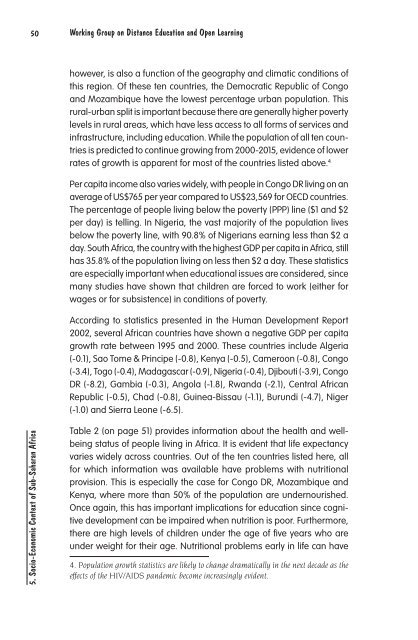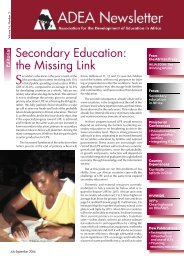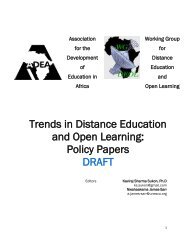Technological Infrastructure and Use of ICT in Education in ... - ADEA
Technological Infrastructure and Use of ICT in Education in ... - ADEA
Technological Infrastructure and Use of ICT in Education in ... - ADEA
You also want an ePaper? Increase the reach of your titles
YUMPU automatically turns print PDFs into web optimized ePapers that Google loves.
50 Work<strong>in</strong>g Group on Distance <strong>Education</strong> <strong>and</strong> Open Learn<strong>in</strong>g<br />
however, is also a function <strong>of</strong> the geography <strong>and</strong> climatic conditions <strong>of</strong><br />
this region. Of these ten countries, the Democratic Republic <strong>of</strong> Congo<br />
<strong>and</strong> Mozambique have the lowest percentage urban population. This<br />
rural-urban split is important because there are generally higher poverty<br />
levels <strong>in</strong> rural areas, which have less access to all forms <strong>of</strong> services <strong>and</strong><br />
<strong>in</strong>frastructure, <strong>in</strong>clud<strong>in</strong>g education. While the population <strong>of</strong> all ten countries<br />
is predicted to cont<strong>in</strong>ue grow<strong>in</strong>g from 2000-2015, evidence <strong>of</strong> lower<br />
rates <strong>of</strong> growth is apparent for most <strong>of</strong> the countries listed above. 4<br />
Per capita <strong>in</strong>come also varies widely, with people <strong>in</strong> Congo DR liv<strong>in</strong>g on an<br />
average <strong>of</strong> US$765 per year compared to US$23,569 for OECD countries.<br />
The percentage <strong>of</strong> people liv<strong>in</strong>g below the poverty (PPP) l<strong>in</strong>e ($1 <strong>and</strong> $2<br />
per day) is tell<strong>in</strong>g. In Nigeria, the vast majority <strong>of</strong> the population lives<br />
below the poverty l<strong>in</strong>e, with 90.8% <strong>of</strong> Nigerians earn<strong>in</strong>g less than $2 a<br />
day. South Africa, the country with the highest GDP per capita <strong>in</strong> Africa, still<br />
has 35.8% <strong>of</strong> the population liv<strong>in</strong>g on less then $2 a day. These statistics<br />
are especially important when educational issues are considered, s<strong>in</strong>ce<br />
many studies have shown that children are forced to work (either for<br />
wages or for subsistence) <strong>in</strong> conditions <strong>of</strong> poverty.<br />
Accord<strong>in</strong>g to statistics presented <strong>in</strong> the Human Development Report<br />
2002, several African countries have shown a negative GDP per capita<br />
growth rate between 1995 <strong>and</strong> 2000. These countries <strong>in</strong>clude Algeria<br />
(-0.1), Sao Tome & Pr<strong>in</strong>cipe (-0.8), Kenya (-0.5), Cameroon (-0.8), Congo<br />
(-3.4), Togo (-0.4), Madagascar (-0.9), Nigeria (-0.4), Djibouti (-3.9), Congo<br />
DR (-8.2), Gambia (-0.3), Angola (-1.8), Rw<strong>and</strong>a (-2.1), Central African<br />
Republic (-0.5), Chad (-0.8), Gu<strong>in</strong>ea-Bissau (-1.1), Burundi (-4.7), Niger<br />
(-1.0) <strong>and</strong> Sierra Leone (-6.5).<br />
5. Socio-Economic Context <strong>of</strong> Sub-Saharan Africa<br />
Table 2 (on page 51) provides <strong>in</strong>formation about the health <strong>and</strong> wellbe<strong>in</strong>g<br />
status <strong>of</strong> people liv<strong>in</strong>g <strong>in</strong> Africa. It is evident that life expectancy<br />
varies widely across countries. Out <strong>of</strong> the ten countries listed here, all<br />
for which <strong>in</strong>formation was available have problems with nutritional<br />
provision. This is especially the case for Congo DR, Mozambique <strong>and</strong><br />
Kenya, where more than 50% <strong>of</strong> the population are undernourished.<br />
Once aga<strong>in</strong>, this has important implications for education s<strong>in</strong>ce cognitive<br />
development can be impaired when nutrition is poor. Furthermore,<br />
there are high levels <strong>of</strong> children under the age <strong>of</strong> five years who are<br />
under weight for their age. Nutritional problems early <strong>in</strong> life can have<br />
4. Population growth statistics are likely to change dramatically <strong>in</strong> the next decade as the<br />
effects <strong>of</strong> the HIV/AIDS p<strong>and</strong>emic become <strong>in</strong>creas<strong>in</strong>gly evident.

















